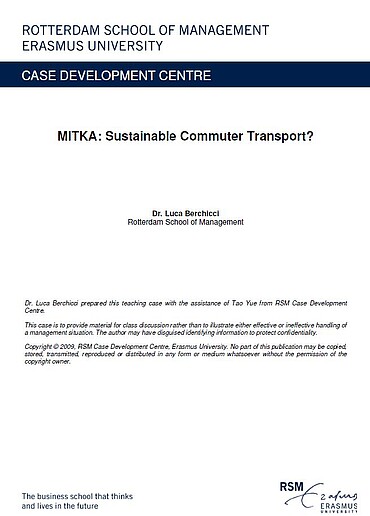Citation Note
Based on published sources; 16 pages.
Follow the 'handle' link to access the Case Study on RePub.
For EUR staff members: the Teaching Note is available on request, you can contact us at rsm.nl/cdc/contact/
For external users: follow the link to purchase the Case Study and the Teaching Note.
Objective
The case has three main conclusions: 1. To create demand for radical ‘green’ innovation requires a balance between environmental and customer needs. 2. Team values influence how market information is assimilated in project development, especially when the project has an ideological goal like environmental improvement. 3. To achieve success, a heterogeneous team must align the divergent interests of different team members.
description
How could an ingenious three-wheel, human-powered, fast, and environmentally friendly vehicle fail to enter the market after heavy investment and years of trials? Mitka’s story demonstrates what makes radical innovation not work.
Abstract
Mitka (short for ‘individual mobility concept for short distance’ in Dutch) was a three-wheel, human-powered vehicle with an electric motor and a maximum speed of 40 km per hour that could cover up to 25 km without recharge. Seven Dutch organizations – two design companies, two vehicle manufacturers, a sportswear manufacturer, a university and a consulting company – joined forces to develop and market Mitka, hoping it would replace cars for short-distance travel. The ultimate goal was to improve the natural environment by introducing radical technological innovation. The project took off supported by the team’s strong conviction and the media’s enthusiastic response. Within four years (1997-2001), Mitka grew from a vague concept to a sleek, life-size mock-up. An additional €600.000 investment (atop the initial €300.000) was secured to build a functioning prototype that could attract more investment. The team was filled with spirit but still faced challenges. Technological complications and an unfamiliar market environment both posed obstacles. Above all, many potential customers had trouble accepting Mitka’s highly innovative design and seeing themselves use it in daily life.
usage
The case asks audiences to reflect on what makes a socially or environmentally good-cause project succeed or fail. When developing an innovative product, should a firm listen to its customers or pursue their own ideas? When is innovation too radical for customers to accept?
